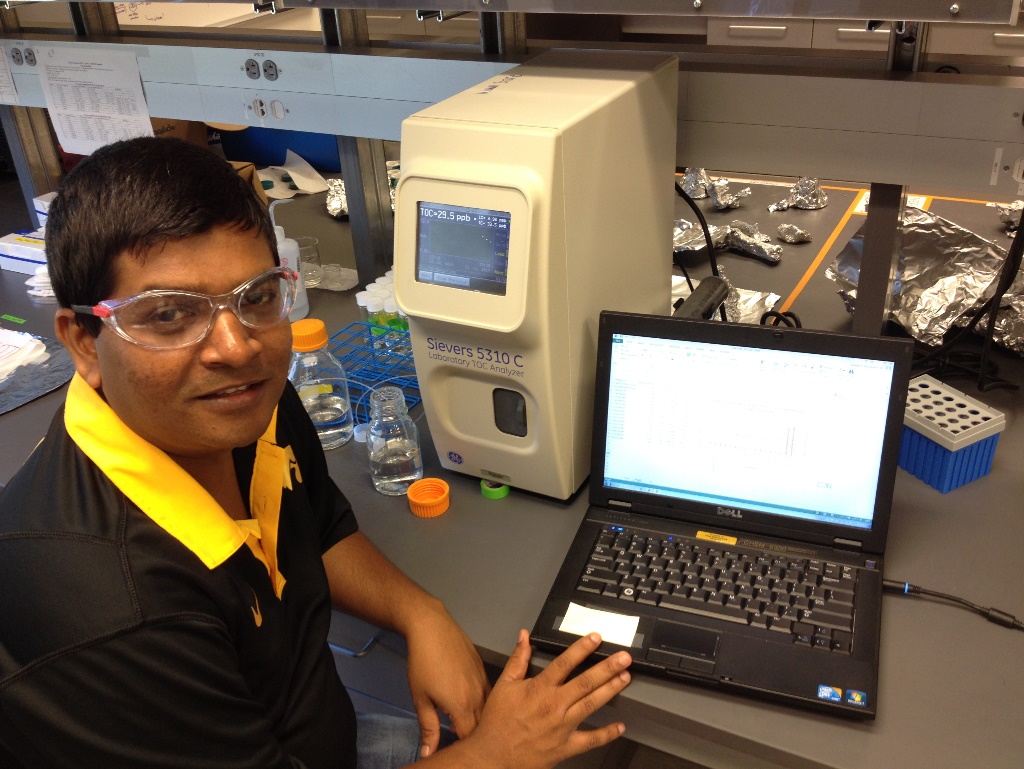I am a third year graduate student from Prof. Betsy Stone research group, University of Iowa. It was a tremendous opportunity for me to participate in IMPACTS (Investigation into Marine Particle Chemistry and Transfer Science) summer 2014 intensive campaign at the Center for Aerosol Impacts on Climate and the Environment (CAICE). These days SIO (Scripps Institution of Oceanography), UCSD is filled with budding atmospheric scientists who are exploring the largest indoor phytoplankton bloom in the world. It is awesome to see everybody is working hard towards the same goal day and night. I am so proud of myself for being a member in this team who are “IMPACTed” by the sea spray aerosols. Originally, I am from Sri Lanka, the island of paradise in Indian Ocean. Being an individual from a small island which is just 270 miles long and 140 miles wide with 800 miles of beaches I was never amazed by seeing the ocean. After I joined the CAICE project I got an opportunity to investigate the importance of ocean to atmospheric science and climate change which changed my perspective about the ocean.
W e think the ocean is full of salty water and the best place for a day out. However, ocean water is not only salt; it contain thousands of organic compounds. These organic compounds are results of phytoplankton and bacterial activities. Breaking waves on the ocean surface generate splash water droplets and air bubbles that scavenge sea salt and organic matter from the sea surface to the atmosphere. These small particles are called sea spray aerosols (SSA) which has important effects in cloud formation and earth’s radiative balance. However, all the organic compounds that can be seen in sea water is not transferred to sea spray aerosol. Some of these compounds get enriched in upper most layer of the ocean (sea surface micro layer) and selectively transferred in to the atmosphere. This selectively transfer mechanism is poorly studied and yet to be fully understood. Therefore, during this study I am collecting sea water, sea surface micro layer and sea spray aerosols and analyze them for organic molecules such as carbohydrates, carboxylic acids, proteins and lipopolysaccharides to understand the selective transfer mechanism of these organic compounds in the ocean to the atmosphere.
e think the ocean is full of salty water and the best place for a day out. However, ocean water is not only salt; it contain thousands of organic compounds. These organic compounds are results of phytoplankton and bacterial activities. Breaking waves on the ocean surface generate splash water droplets and air bubbles that scavenge sea salt and organic matter from the sea surface to the atmosphere. These small particles are called sea spray aerosols (SSA) which has important effects in cloud formation and earth’s radiative balance. However, all the organic compounds that can be seen in sea water is not transferred to sea spray aerosol. Some of these compounds get enriched in upper most layer of the ocean (sea surface micro layer) and selectively transferred in to the atmosphere. This selectively transfer mechanism is poorly studied and yet to be fully understood. Therefore, during this study I am collecting sea water, sea surface micro layer and sea spray aerosols and analyze them for organic molecules such as carbohydrates, carboxylic acids, proteins and lipopolysaccharides to understand the selective transfer mechanism of these organic compounds in the ocean to the atmosphere.
Thilina Jayarathne, Research Assistant, Stone Research Group, Department of Chemistry at University of Iowa.

